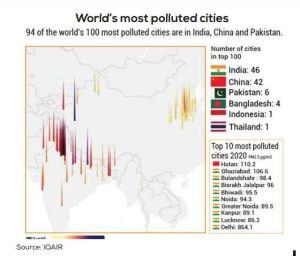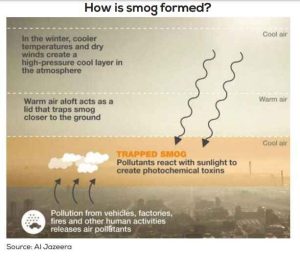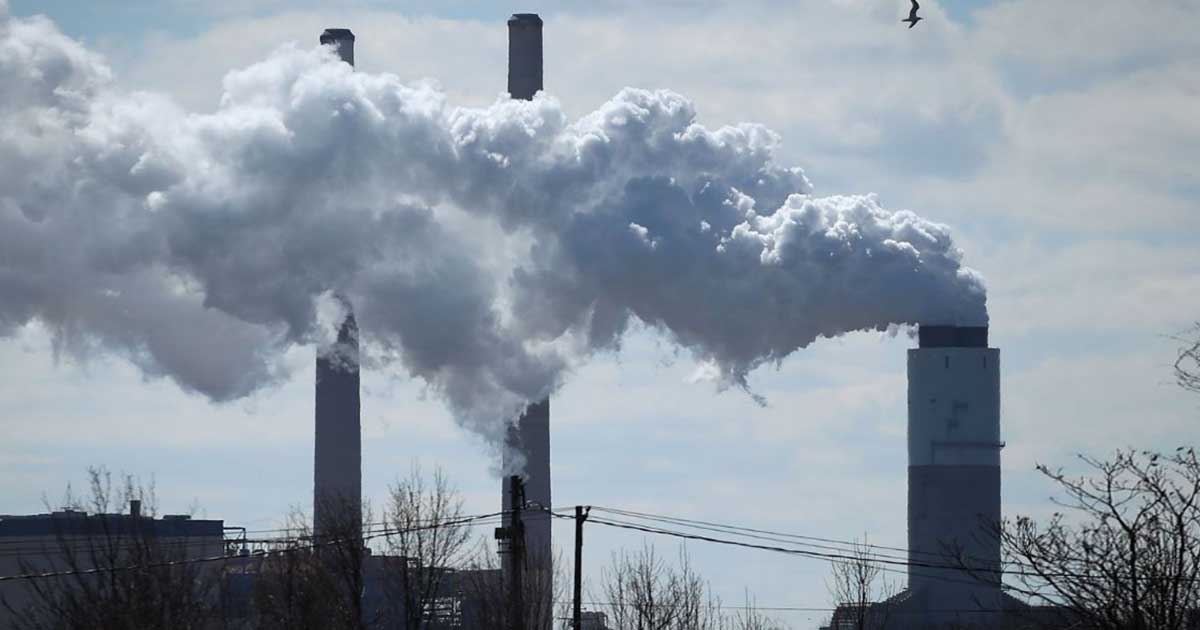Vehicle exhaust, coal-burning power plants, garbage incineration, brick kilns, and farmers burning post-harvest rice stubble all contribute to the deadly pollution that blankets northern India and Pakistan. This results in the creation of the most poisonous air in the world, measured by the amount of “microparticle” pollutants— those small enough to lodge deep inside people’s lungs, enter their bloodstreams, and cause cardiovascular and lung disease. Fourteen of the top 15 cities in the world with the highest particulate matter (PM) 2.5 pollution levels are located in India and Pakistan.
The air quality severely harms the health of millions of people and their future economic potential in South Asia. The risk of heart and lung disease and strokes is elevated by high concentrations of fine particulate matter (PM) 2.5. Air pollution also results in a 2.9-year decrease in the global average life expectancy. In India, air pollution reduces
average life expectancy by five years. A recent study found that the typical life spans of Indians living on the Indo-Gangetic Plain are up to seven years shorter than without air pollution.
Read more: How pollution is destroying Quetta city?
As winds and rain decrease every winter, a brown haze high in sulfur and metals like lead accumulates over the subcontinent. For most of this winter, as for many earlier years as well, Mumbai, the commercial hub of India, had been shrouded in thick smog. The PM-induced grey haze has wholly obscured the city’s skyline. Mumbai experienced 36 days of “poor” air quality between November and January, posing a health risk to even healthy individuals. In winter, there were significant smog-related disruptions in Pakistan’s Punjab province, which produces 60% of the country’s output; school holidays were prolonged, flights were diverted or delayed, and highways were shut down overnight.

Decades of efforts to reduce pollution in India have failed due to a lack of political will and efficient government. Burning anything besides fuels was prohibited under an ambitious air pollution control regulation from 1981, but it was never really implemented. Worse still, Punjab state in India accidentally pushed farmers hastily clear their fields for winter wheat by burning enormous acreages of rice residue after each harvest to save scarce water by announcing a delay in the rice-growing season.
When pollution levels reached extremes in Delhi, the local authorities shut down a coal-fired power plant and occasionally restricted automobile traffic. The Indian government established a commission in 2020 to enhance the capital city’s air quality. Despite the various government initiatives and COVID lockdowns, the air quality did not improve significantly. According to the Center for Science and the Environment in New Delhi, more substantial, enforceable, and broad reforms are needed.
Read more: Be a part of solution, not pollution
In Pakistan, the lack of political will and governance flaws have been the main handicaps to achieving long-lasting progress. Even a national network of stations for measuring air quality is absent in Pakistan, making it impossible for the people to know the full scope of the issue. Air quality in Lahore and three other cities were dangerously worse than the government claimed when activist Abid Omar set up the first public monitoring stations in 2017. This finding was quickly supported by monitors deployed at U.S. diplomatic missions in Pakistan. The citizen monitoring project, now known as the crowd-sourced Pakistan Air Quality initiative, was followed by some official initiatives. In 2020, the Pakistani government issued an order requiring fuel suppliers to stop importing “Euro 2,” a cheaper and heavier grade of gasoline. The Punjab province of Pakistan restricted the burning of grain stubble to clear farms and mandated improvements to conventional, coal-fired brick kilns, but these rules need to be adequately enforced.
The governments of India and Pakistan cannot cooperate on the smog situation due to their mutual hostility, and officials in each country point the finger at the other. The main accomplishment of the Indian Pakistani dialogue on environmental or resource issues, the 1960 Indus Waters Treaty on sharing the Indus River and its tributaries, has occasionally been threatened by the Kashmir issue. Despite six decades of struggle, including two wars, the countries have maintained this agreement, which the World Bank calls “one of the most
successful international treaties.” It is once again being threatened by India saying it will pull out.

With their contempt for political boundaries, the world’s expanding environmental challenges have opened up new possibilities for achieving peace in seemingly intractable conflicts. Since academics Geoffrey Dabelko and Ken Conca helped outline the concept in a book in 2002, Environmental Peacemaking, the discipline of “environmental peacebuilding” has been growing. Three significant treaties between India and its neighbors on sharing the river waters flowing from the Himalayas were recognized in the chapter on South Asia in that edition as the region’s promising beginning. Although those agreements have been upheld throughout the years, governments have not continued their collaboration to lessen the airborne toxins that they all share.
Read more: Pakistan’s struggle with air pollution
Creating civic campaigns at the local, state, and provincial levels will be crucial to put popular demands on the national governments’ agendas. Two megacities— Delhi and Lahore—would be essential to any efforts urging the two countries to separate politics from clean air. The World Bank has indicated that the more coordinated the pollution controls are, the more advantageous and cost-effective they will be. The ideal situation would be for the two countries’ governments to collaborate on data exchange and policy development while each is working towards a locally set goal. As a result, India and Pakistan could give more straightforward or affordable pollution control measures—like controlling brick kilns—priority over more complex or expensive ones, like dismantling coal-fired power plants. In the end, cooperation is the key.


